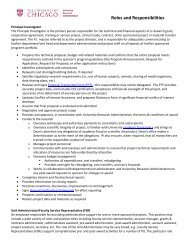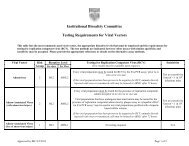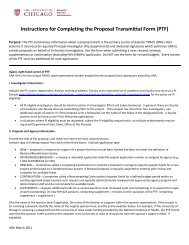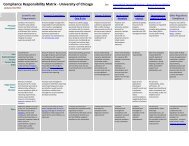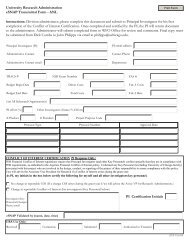Biosafety Considerations for Research with Lentiviral Vectors
Biosafety Considerations for Research with Lentiviral Vectors
Biosafety Considerations for Research with Lentiviral Vectors
Create successful ePaper yourself
Turn your PDF publications into a flip-book with our unique Google optimized e-Paper software.
Potential <strong>for</strong> generation of replication competent lentivirus (RCL) from HIV-1 based lentivirus vectors: The potential <strong>for</strong> generation of RCL from HIV-1 basedlentivirus vectors depends upon several parameters, the most important of which are:• The number of recombination events necessary to reassemble a replicationcompetent virus genome, and• The number of essential genes that have been deleted from thevector/packaging system.On this basis, later generation lentivirus vector systems are likely to provide <strong>for</strong> a greatermargin of personal and public safety than earlier vectors, because:• They use a heterologous coat protein (e.g., VSV-G) in place of the nativeHIV-1 envelope protein (However, the use of the certain coat proteins, suchas VSV-G, may broaden the host cell and tissue tropism of lentivirus vectors,which should also be considered in the overall safety assessment by theIBC),• They separate vector and packaging functions onto four or more plasmids,and• They include additional safety features (e.g., they do not encode Tat, which isessential <strong>for</strong> replication of wild-type HIV-1).In contrast, earlier vector systems (such as two-plasmid vector systems) may have ahigher potential <strong>for</strong> generation of RCL.RCL testing: The National Gene Vector Laboratory (NGVL) has produced over 60liters of HIV-1 vector and has screened supernatant and cells from different vectorsystems, using different assays, <strong>with</strong>out detecting RCL (K. Cornetta, personalcommunication of unpublished data). This suggests that the frequency of RCLgeneration using lentivirus vectors is very low. It may not, however, be zero. There is aneed <strong>for</strong> continued investigation of RCL generation using lentivirus vectors, in order toin<strong>for</strong>m and advance the field of lentivirus vector technology.The FDA requires that lentiviral vector stocks used in human clinical trials be tested <strong>for</strong>RCL. Individual research laboratories conducting preclinical research often use onlysmall volumes (e.g., a few milliters) of lentivirus vectors expressing lower risk transgenessuch as GFP. While these laboratories are not mandated to characterize vector stocks,such testing should be encouraged. However, RCL testing requires expertise <strong>with</strong> theappropriate assays and such expertise may not be available in laboratories that do notwork regularly <strong>with</strong> infectious lentiviruses. In such laboratories, the use of a positivecontrol may increase risk to the investigator as compared to use of the test material.IBCs may make containment assignments <strong>with</strong>out requiring such testing by undertakinga risk assessment that considers the nature of the specific vector system being used andoverall past experience <strong>with</strong> the system.Animal studies: Some animals, such as wild-type mice, cannot support replication ofinfectious HIV-1. As a result, the potential <strong>for</strong> shedding of RCL from such animals is verylow (even if RCL were present in the original vector inoculum). IBCs may consider thebiosafety issues associated <strong>with</strong> animal husbandry and housing after the initial injectionseparately from the initial inoculation itself. In general, the initial delivery of vector should



